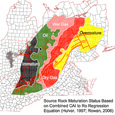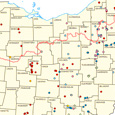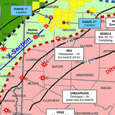Infrastructure, Investments Are Coming to the Utica Shale
Tuesday, February 4, 2014

PITTSBURGH, Pa. — If you think the natural gas boom has taken off in the past year, economists and industry officials say it is only the beginning.
That’s was the general consensus at the 2014 Marcellus-Utica Midstream Conference held in Pittsburgh Jan. 29-30.
Estimates for new pipelines, gathering lines, compressors, fractionators (cracker plants) and other systems to separate the gas in Ohio’s Utica shale range from $12 billion to $15 billion per year through 2020. The economists said if companies are willing to invest that kind of money, it means there is lots of gas under the ground.
Infrastructure
Rick DeCeasar, of the Willbros, Group, said more infrastructure is needed to get the gas from the wells to the customers. However, different plants are needed so that the gases and natural gas liquids can be separated.
DeCeasar said infrastructure construction costs in Pennsylvania, West Virginia and Ohio are estimated between $75-87 billion a year.
Randy Crawford, of EQT Corp. said the weather and terrain are the two main challenges in building pipelines in the Marcellus and Utica regions, but he expects 50 percent of the U.S. natural gas production growth to come from the region by 2020.
Still need demand
Peter Terranova, vice president for Midstream Assets and Services for UGI Energy Services Inc., said the gas production in the northeastern United States has doubled since 2012.
Terranova said there needs to be a bigger demand in order for the market to sustain a profitable price, and said the United States needs to become a net exporter by 2016.
He said the Northeast will supply gas to the other regions of the United States 80 percent of the time by 2017.
Terranova said it is vital that Marcellus and Utica producers seek liquid markets outside the region in order for the gas to stay profitable.
Production timeline
Bradley Olsen, of Tudor, Pickering, Holt and Co., said the production in the Marcellus and Utica is outpacing what analysts thought possible.
He looks for the Marcellus/Utica to supply the entire U.S. by 2020, or at least 15 bcf/d (billion cubic feet per day.) In the cold weather like what the U.S. has experienced this year, analysts estimate the country uses around 20 bcf/d.
Olsen said he is confident that as more wells come online, the Marcellus/Utica will be able to supply the Northeast — including the metropolitan areas of Boston and New York City — 60 percent of the year with all of its natural gas.
However, the cost of new pipelines could hinder the progress, he said, adding it is more expensive to build new pipelines than to send the gas to the Gulf of Mexico, depending on market prices and all other costs. He estimated it could cost 30-60 cents per mc/f to send the gas through newly constructed pipelines.
Olsen said there is a market for natural gas in the Gulf of Mexico area because of the petro-chemical processing plants and local power generation plants already there.
He predicts most natural gas liquids will make their way East in 2016, either by barge or rail and then be shipped to the Gulf of Mexico area.
Other presenters at the conference discussed how some existing pipelines will actually change the direction the product flows across the United States. Some pipelines that are flowing east to west or north to south will change direction in the near future, depending on market prices and what gas product needs to get where.
Dominion Transmission
Donald Raikes, of Dominion Transmission, said their Cove Point project, which is located in Maryland off of Chesapeake Bay, could lead the way. He said the northeastern part of the United States is transferring from a market area to a supply area for gas. He said the shale plays will change the area from a gas importer to a gas exporter.
He said there is no doubt the Northeast will have excess production by 2016.
The Cove Point project is undergoing a change in order to export gas, and Dominion is currently building a $3.4 billion liquefier at the site. All other infrastructure for exporting already exists.
Almost all of the presenters at the Pittsburgh conference agreed the Marcellus and Utica shale area needs more infrastructure in order to get the products from the wellhead to the system that can produce the natural gas liquid products.
And many business leaders and economists agreed the area will need manufacturers that can use the gases to produce products.




